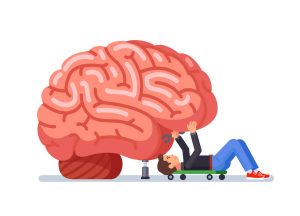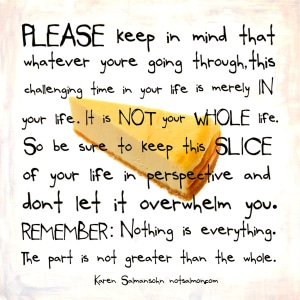 Are you an optimist or a pessimist? If you feel like you’ve been looking at life with a negative lens lately, here is how to think like an optimist in 6 steps. Train your brain to stop thinking pessimistically – so you can feel happier and more confident.
Are you an optimist or a pessimist? If you feel like you’ve been looking at life with a negative lens lately, here is how to think like an optimist in 6 steps. Train your brain to stop thinking pessimistically – so you can feel happier and more confident.
Bad stuff.
It happens to all of us.
If you’re feeling particularly angry at life right now, I’ve got a terrific tool which has been proven to help people to think like an optimist.
How To Think Like An Optimist
 Dr. Martin Seligman, director of the U of Pennsylvania’s Positive Psychology Center, says a lot of your love (or hate) for life is dependent upon “the stories” you tell yourself.
Dr. Martin Seligman, director of the U of Pennsylvania’s Positive Psychology Center, says a lot of your love (or hate) for life is dependent upon “the stories” you tell yourself.
This “self-talk” can either enable you to persist in the face of challenges – or completely disable you.
What makes someone a Pessimist?
Martin Seligman describes it like this: “Pessimists, who generally don’t bounce back easily from bad times, see failure as permanent, pervasive, and personal. They tell themselves things like: ‘My life is ruined!’ and ‘This bad thing is going to undermine everything.’”
What makes someone an Optimist?
 Optimistic people, in contrast, tell themselves that setbacks are temporary – confined to that one situation. Optimists tend not to get angry at the universe.
Optimistic people, in contrast, tell themselves that setbacks are temporary – confined to that one situation. Optimists tend not to get angry at the universe.
Optimists simply assume that bad events are an exception – and good things will continue to happen.
Meaning?
If lately a lot of bad stuff has been happening, you’ve got to mindfully train your brain to think like an optimist – so you can feel happier and more confident again.
6 Steps To Think Like An Optimist
Dr. Seligman has partnered up with Dr. Karen Reivich to create a specific process for thinking more like an optimist – that’s literally as easy as A B C D E.
Here’s how it works:
- A. When we encounter Adversity (that’s the “A” step in this process), we react by thinking about it.
- B. Our thoughts congeal into Beliefs ( the “B” step in this process).
- C. These beliefs have Consequences (the “C” step in this process).
- D. This brings us to the “D” step – which is all about “Disputing” the negative beliefs – so that you can get to …
- E. Energizing yourself with positive emotions.
 The 6 Steps To Optimism Further Explained…
The 6 Steps To Optimism Further Explained…
1. Get journal.
Write down the 5 letters A, B, C, D. E on 5 different pages of your journal.
2. Start with the letter “A”
Write down the nature of your “Adversity.”
Describe the situation in terms of…
Think of yourself as a reporter writing down the facts and nothing but the facts.
Be as objective and as unemotional as possible.
3. Write about your “B” – what negative “Beliefs” has your Adversity triggered?
- Who does your adversity make you feel like you are being – what kind of person?
- How does your adversity make you feel about your life – what kind of life are leading?
- What kind of world does it make you feel you live in?
For example…
- “I suck.”
- “Human beings all suck!”
- “You can’t trust anyone!”
- “It’s because I’m fat, old, female etc… that this happened!”
To identify your “Beliefs,” slow down and listen to your self-talk.
Specifically listen for beliefs that sound “permanent, pervasive, and personal.”
For example…
- “I’ll never get a job” (permanent).
- “This always happens” (pervasive).
- “I’m an idiot” (personal).
It takes practice and lots of self-awareness to identify your “self-talk” or “story,” but it’s important that you learn to recognize your self-defeating (and inaccurate) Beliefs.
Take some notes on the chatter in your brain.
Listen to yourself. Write it down. Capture it.
4. Describe the “Consequences” of your Beliefs.
- How are you feeling?
- How are you behaving?
 Become aware of how your wrongly held beliefs might be causing you to think or behave negatively. Is there anything you’ve stopped doing? Any new habits you’ve picked up?
Become aware of how your wrongly held beliefs might be causing you to think or behave negatively. Is there anything you’ve stopped doing? Any new habits you’ve picked up?
For example:
In other words, how has your Adversity changed you?
5. “Dispute” what you’ve written so far with specific evidence that points out the flaws in your Beliefs.
Question the reality and accuracy of your interpretation.
For example…
“I’ll never get a job.”
- Is that true?
- Says who?
- Have there been times when you have thought you’d never find work and did?
“This always happens.”
- Can you think of an exception?
“I’m an idiot.”
- Compared to what/who?
- What is your definition of idiot, anyway?
- Have there been times when you’ve shown practical or academic smarts?
Come up with an alternative (and more realistic) way of looking at what happened.
For example:
- “Maybe I didn’t get this job because I was overly qualified or they hired someone’s sister.”
- “Maybe this person broke up with me not because I’m fat, but because they have fear of commitment.”
Restate your beliefs so they’re more accurate.
Start your sentences with…
- “My original beliefs are not completely true because . . .”
- “A lucky outcome from all this might be . . . and I can do that because.”
6. “Energize” your mind and spirit.
Disputing often puts us in a resourceful place. When you have been effective in disputing the beliefs, you feel a surge of energy, a sense of renewed hope.
Write about how your answers to #4 improved your “Energy.”
Yes, You Can Be More Optimstic
 Stop the “negative loop” of self-defeating self-stories and focus instead on the “upside of suffering and stress.”
Stop the “negative loop” of self-defeating self-stories and focus instead on the “upside of suffering and stress.”
(I write about this more in an article here.)
Swap feeling like you’re wearing a “KICK ME” sign – and start feeling like you’re wearing a “KICK ASS” sign!
Recognize that you are strong and worthy – and you have it within you to create the life you want for yourself – if you just take each day one day at a time!
Get more support to think optimistically
Check out my bestselling book Think Happy!
P.S. Before you zip off to your next Internet pit stop, check out these 2 game changers below - that could dramatically upscale your life.
1. Check Out My Book On Enjoying A Well-Lived Life: It’s called "Your To Die For Life: How to Maximize Joy and Minimize Regret Before Your Time Runs Out." Think of it as your life’s manual to cranking up the volume on joy, meaning, and connection. Learn more here.
2. Life Review Therapy - What if you could get a clear picture of where you are versus where you want to be, and find out exactly why you’re not there yet? That’s what Life Review Therapy is all about.. If you’re serious about transforming your life, let’s talk. Learn more HERE.
Think happier. Think calmer.
Think about subscribing for free weekly tools here.
No SPAM, ever! Read the Privacy Policy for more information.
One last step!
Please go to your inbox and click the confirmation link we just emailed you so you can start to get your free weekly NotSalmon Happiness Tools! Plus, you’ll immediately receive a chunklette of Karen’s bestselling Bounce Back Book!


 Are you an optimist or a pessimist? If you feel like you’ve been looking at life with a negative lens lately, here is how to think like an optimist in 6 steps. Train your brain to stop thinking pessimistically – so you can feel happier and more confident.
Are you an optimist or a pessimist? If you feel like you’ve been looking at life with a negative lens lately, here is how to think like an optimist in 6 steps. Train your brain to stop thinking pessimistically – so you can feel happier and more confident. Dr. Martin Seligman, director of the U of Pennsylvania’s Positive Psychology Center, says a lot of your love (or hate) for life is dependent upon
Dr. Martin Seligman, director of the U of Pennsylvania’s Positive Psychology Center, says a lot of your love (or hate) for life is dependent upon  Optimistic people, in contrast, tell themselves that
Optimistic people, in contrast, tell themselves that  The 6 Steps To Optimism Further Explained…
The 6 Steps To Optimism Further Explained…

 Stop the “negative loop” of self-defeating self-stories and focus instead on the “
Stop the “negative loop” of self-defeating self-stories and focus instead on the “